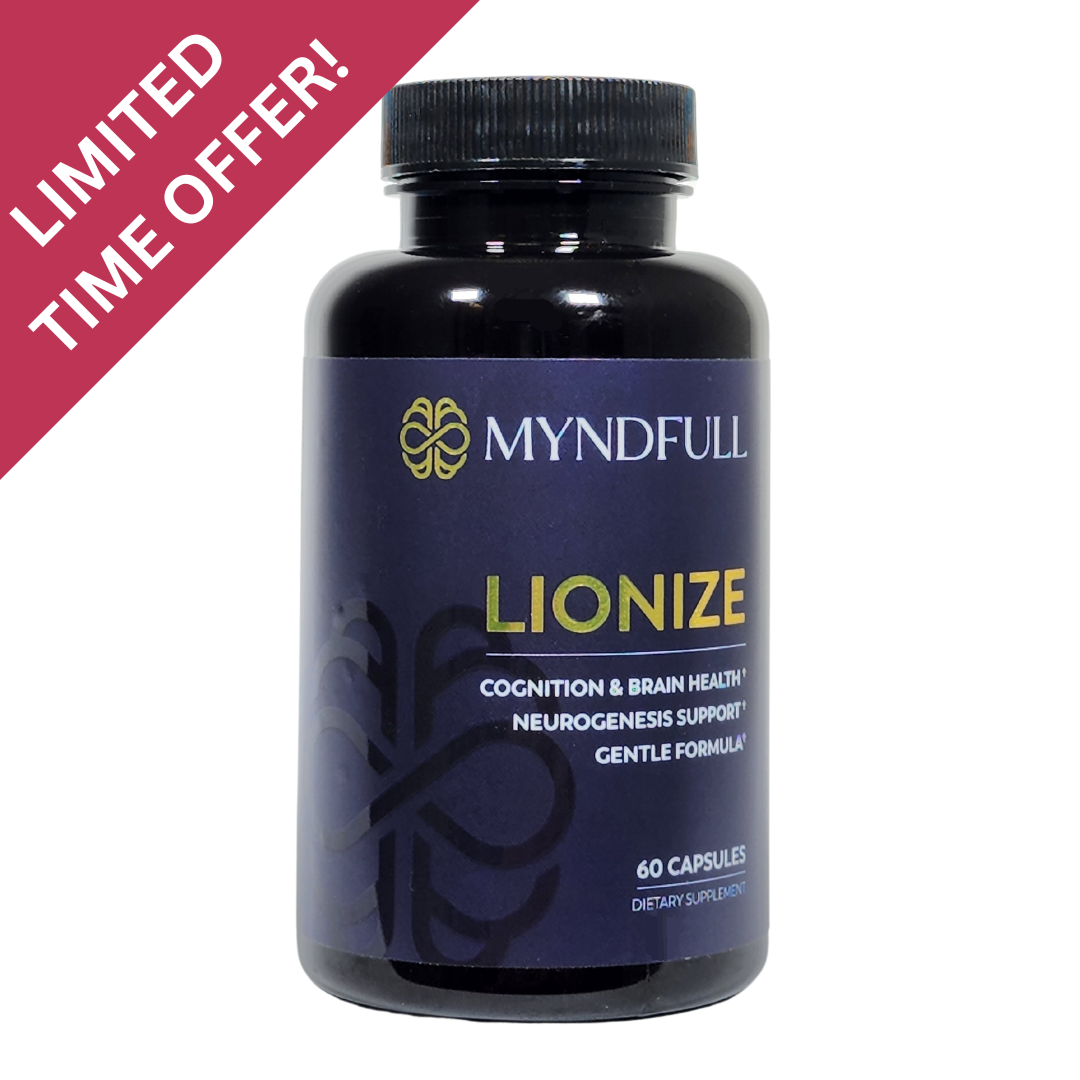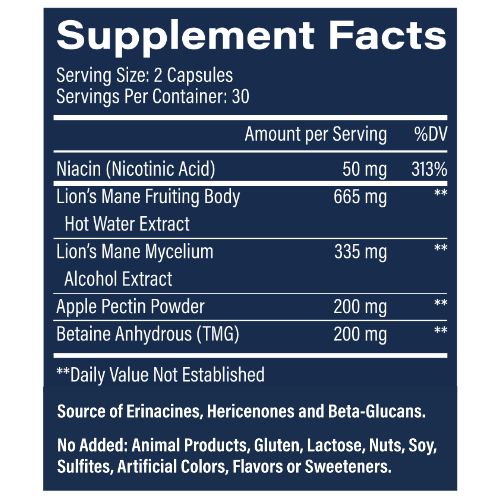Niacin. Vitamin B3. I know…it sounds boring. It doesn’t even get a whole “vitamin” letter to itself. It sounds like the kind of exciting nutrient you find in Cheerios. Well, guess what…it actually does some really important things. A lot of experts even classify it as a brain enhancing nootropic. If don't have enough of it, it can fundamentally impact the way your body functions on a cellular level. Severe shortages cause a condition called pellagra, accompanied by its dreaded 3 “D”s: dermatitis, diarrhea, and dementia (Hegyi et al., 2004). On the other hand, taking a lot of it in a short period can cause redness and burning over your whole body. How’s that for exciting?
In this post, we’ll take a closer look at this under-appreciated and often misunderstood nutrient. We’ll go through what it is, how it helps keep your body functioning properly day-to-day, and how to safely and effectively use it to give yourself a performance enhancing boost.
So what is Niacin?
Short answer: Niacin, also known as vitamin B3, is an essential nutrient that plays a crucial role in many bodily processes, like energy production and DNA repair and is a factor in more than 500 intracellular reactions.
Niacin (also known as vitamin B3, also known as nicotinic acid) is found naturally in a lot of foods, especially meat, fish, and nuts. For those looking for a more precise, intentional application, niacin is commonly available via supplements.

The term “niacin” usually refers to one of two main forms: nicotinic acid, which is the most basic form, and nicotinamide, which is nicotinic acid with an amide group added to the molecule. These two forms are often referred to interchangeably, and they have similar structures, but they actually have distinct effects in the body (Mackay et al., 2012).
- Nicotinic acid is metabolized faster, and it has stronger vasodilatory action, making it better for improving blood flow.
- Nicotinamide doesn’t appear to have the same circulatory impacts. It’s more associated with the energy-production attributes of niacin.
As stated before, nicotinic acid is used to make nicotinamide in the body, so consuming the more basic form is likely to give you the benefits of both. There are other derivatives that are sold as niacin under descriptors like “extended release” or “flush-free”, but the science is less clear on the benefits and drawbacks of those.
Overall, niacin is an essential nutrient that plays a crucial role in the maintenance of cellular integrity and energy production and is involved in more than 500 intracellular reactions. (Viljoen et al., 2015).
Got it. What can niacin do for me?
Short answer: Niacin plays a critical role in a lot of processes in the body, but a few of the stand-out effects are energy production, improved blood flow, cholesterol regulation, and brain health.
Niacin is involved in a lot of processes in the body…over 500 according to researchers, actually. Laying them all out would be be difficult, so here are a few of the high points:
- NAD formation - Niacin is the foundation of NAD (nicotinamide adenine dinucleotide). NAD is used in most metabolic processes where the energy content locked in carbohydrates, fats, and proteins are released and converted into ATP (adenosine triphosphate), the standard energy unit used in your body’s cells (Bourgeois & Moss, 2010).
- Cholesterol management - Niacin has long been recognized for its powerful lipid-modifying effects. At therapeutic doses, it’s been shown to be effective in both depressing LDL (bad) cholesterol and supporting HDL (good) cholesterol (Altschul et al., 1955).
- Circulation boost - Niacin, specifically nicotinic acid stimulates the release of prostaglandins that cause vasodilation, or the widening of blood vessels (Kamanna et al., 2009). This can have the effect of lowering blood pressure, and is also speculated by some to allow for enhanced bloodborne distribution of nutrients deeper into the furthest extremities of capillaries (Rootman et al., 2022).
- Reduced inflammation and oxidative stress - Niacin has anti-inflammatory and antioxidant properties, which can help reduce inflammation and oxidative stress.
- Brain health - Niacin appears to support brain health in several ways:
- Niacin deficiency is associated with brain fog, headache, fatigue and even depression and memory loss in extreme cases (Niacin Fact Sheet, 2022).
- Niacin supports the production of neurotransmitters and studies suggest that it may even help regulate production of brain-derived neurotrophic factor (BDNF), which helps with nerve cell growth (Cui et al., 2010).
- Researchers say dietary niacin may even protect against Alzheimer's Disease and age related cognitive decline (Morris et al., 2004).
- A human study showed that higher intake of B vitamins throughout young adulthood was associated with better cognitive function in midlife (Quin et al., 2017).
Overall, niacin is a powerful supplement that can offer numerous benefits for energy, cognitive function and mental clarity. By supporting healthy cell function, improving blood flow, including to the brain, and reducing inflammation and oxidative stress, niacin can help improve metabolism, energy levels, and overall health.
Anything else I should know?
Short answer: Niacin should be used carefully. It is well tolerated at low levels, but it is possible to trigger side effects ranging from nuisance to dangerous, particularly at very high doses.
Dosage
The FDA recommended daily allowance of niacin for a healthy adult is 14-16 mg. This is enough to be healthy, but is lower than a lot of recommendations for therapeutic doses. Recommended dosage for niacin as a supplement varies depending on individual needs and goals. Generally, doses intended to have an enhancing or nootropic effect fall between 50-500 mg per day. With that said, those levels run the risk of side effects if preventative steps aren’t taken.
Niacin Flush
The most common negative side effect of niacin is known as “niacin flush”. Everyone will react a little differently, but in general, when someone not used to it takes a dose of around 50mg or above, they start to run the risk of symptoms including skin redness, tingling, and other discomfort. This generally passes within a couple hours and is more of a hassle than a danger, but it can be quite unpleasant for some people.

Niacin Flush Mitigation
It is possible to treat or potentially avoid niacin flush by taking aspirin either when the symptoms arise or about 30 minutes before taking your niacin. There is even evidence for more natural options like eating an apple with your dose or taking pectin with it (Moriarty, et al., 2012). The human body develops a tolerance for niacin in a lot of cases, so many people who elect to take higher doses of niacin (100mg+) work up to their target dose by starting with smaller amounts and gradually increase.
Other Common Side Effects
Other potential side effects of niacin include gastrointestinal discomfort, dizziness, and headache. These side effects are generally mild and can be minimized by following recommended dosages and taking niacin with food.
More Serious Risks
Very high doses or moderately high doses taken for extended periods should be approached with caution. In very high amounts, niacin can cause liver damage. It is important to monitor liver function when taking high doses of niacin and to consult with a healthcare provider if any signs of liver damage are noticed.
Excess niacin is eliminated via methylation so that it can be passed in the urine (Gasperi et al., 2019). This means a small molecular structure known as a methyl group is attached to it. Methyl groups are normally plentiful in the body, but they’re used for other important purposes as well. Chronic exhaustion of methyl group supply can cause problems of its own, so it should be avoided.
While niacin is generally considered safe when taken at recommended dosages, it is important to consult with a healthcare provider before adding any new supplements to your routine, particularly if you have any medical conditions or are taking medications.
In conclusion…
Overall, niacin has unique mechanisms of action that make it an important nutrient in ensuring optimal health. It’s a fundamental component in our well-being that a lot of people don’t even think twice about. Without niacin as the main building block of NAD, we wouldn’t even be able to unlock the energy from the food we eat. Add to that, its role in over 500 other cellular interactions, and niacin is manifestly one of the most under-appreciated nutrients out there.
If you're looking for an effective way to support energy metabolism, improve cognitive function and support brain health, niacin supplementation is definitely worth considering. With its many benefits and minimal side effects, it's a great choice for anyone looking to enhance their performance and stay sharp for years to come.
References:
Altschul, R., Hoffer, A., & Stephen, J. D. (1955). Influence of nicotinic acid on serum cholesterol in man. Archives of Biochemistry and Biophysics, 54(2), 558-559. https://doi.org/10.1016/0003-9861(55)90070-9
Bourgeois, C., & Moss, J. (2010). Encyclopedia of Dietary Supplements (P. M. Coates, J. M. Betz, M. R. Blackman, G. M. Cragg, M. Levine, J. Moss & J. D. White, Eds.) (2nd ed., pp. 562-569). New York, NY: Informa Healthcare.
Cui, X., Chopp, M., Zacharek, A., Roberts, C., Buller, B., Ion, M., & Chen, J. (2010). Niacin treatment of stroke increases synaptic plasticity and axon growth in rats. Stroke, 41(9), 2044-2049. https://doi.org/10.1161/STROKEAHA.110.589333
Gasperi, V., Sibilano, M., Savini, I., & Catani, M. V. (2019). Niacin in the Central Nervous System: An Update of Biological Aspects and Clinical Applications. Journal of Molecular Science, 20(4), 974. https://doi.org/10.3390/ijms20040974
Hegyi, J., Schwartz, R. A., & Hegyi, V. (2004). Pellagra: Dermatitis, dementia, and diarrhea. International Journal of Dermatology, 43(1), 1-5. https://doi.org/10.1111/j.1365-4632.2004.01959.x
Kamanna, V. S., Ganji, S. H., & Kashyap, M. L. (2009). The mechanism and mitigation of niacin-induced flushing. International Journal of Clinical Practice, 63(9), 1369-1377. https://doi.org/10.1111/j.1742-1241.2009.02099.x
Mackay, D., Hathcock, J., & Guarneri, E. (2012). Niacin: Chemical forms, bioavailability, and health effects. Nutrition Reviews, 70(6), 357-366. https://doi.org/10.1111/j.1753-4887.2012.00479.x
Moriarty, P. M., Backes, J., Dutton, J. A., He, J., Ruisinger, J. F., & Schmelzle, K. (2012). Apple pectin for the reduction of niacin-induced flushing. Journal of Clinical Lipidology, 7(2), 140-146. https://doi.org/10.1016/j.jacl.2012.11.005
Morris, M. C., Evans, D. A., Bienias, J. L., Scherr, P. A., Tangney, C. C., Herbert, L. E., Bennett, D. A., Wilson, R. S., & Aggarwal, N. (2004). Dietary niacin and the risk of incident Alzheimer's disease and of cognitive decline. Journal of Neurology, Neurosurgery, and Psychiatry, 75(8), 1093-1099. https://doi.org/10.1136/jnnp.2003.025858
National Institutes of Health (2022, November 18). Niacin Fact Sheet for Health Professionals. National Institutes of Health Office of Dietary Supplements. Retrieved May 9, 2023, from https://ods.od.nih.gov/factsheets/Niacin-HealthProfessional/#en2
Rootman, J. M., Kiraga, M., Kryskow, P., Harvey, K., Stamets, P., Santos-Brault, E., Kuypers, K. P., & Walsh, Z. (2022). Psilocybin microdosers demonstrate greater observed improvements in mood and mental health at one month relative to non-microdosing controls. Scientific Reports, 12(11091). https://doi.org/10.1038/s41598-022-14512-3
Viljoen, M., Swanepoel, A., & Bipath, P. (2015). Antidepressants may lead to a decrease in niacin and NAD in patients with poor dietary intake. Medical Hypotheses, 84(3), 178-82. https://doi.org/10.1016/j.mehy.2014.12.017








